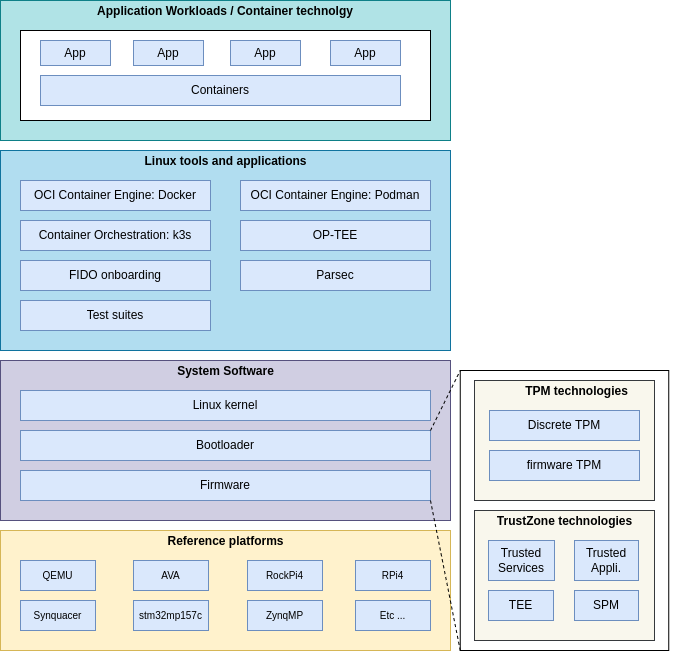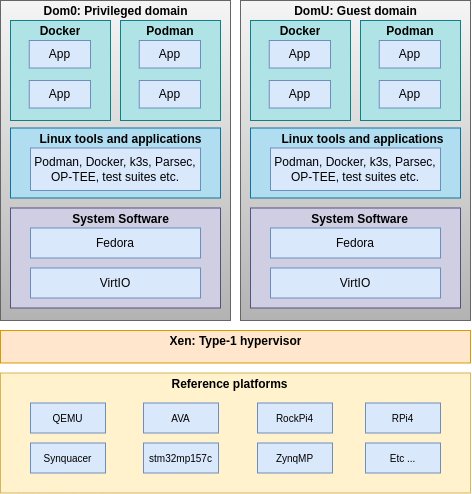System Architectures
From a high level, TRS provides two main variants, the baremetal variant and the virtualization variant. Both are built from the same sources with minor modifications.
Baremetal and virtualization are two independent software deployment strategies for computer systems. Baremetal refers to the installation and running of an operating system without any intervening software layers. In other words, the OS directly interacts with the machine’s physical hardware, including the CPU, memory, storage, and networking devices etc.
Virtualization, on the other hand, involves the creation of one or more virtual machines (VMs) that run on top of a hypervisor, which is a software layer that abstracts the underlying physical hardware and exposes it to the VMs as a set of virtual hardware components. Each VM have the ability to run its own operating system, which interacts with the hypervisor’s virtual hardware. This essentially means that it is possible to run several different operating systems concurrently on the same physical hardware.
So, baremetal systems communicate directly with the real hardware, whereas virtualized systems communicate with the hypervisor’s virtual hardware. Ultimately, the decision between bare metal and virtualization is determined by the individual use case and system requirements. Virtualization is often used in data centers and other business contexts where flexibility, administration, and effective resource utilization are essential. But there is a trend where other markets started looking at running virtualized environments. Automotive is one, but we’ve even seen that mobile handset have use cases where they want to leverage virtual environments for various workloads.
Since TRS have the ability act as both baremetal and a virtualized architecture, with and without using container technologies, we believe that TRS is well suited for a lot of use cases and scenarios.
Baremetal architecture
Conceptually, TRS has code running in every architectural layer. With an Armv8-A device, this means that code will run on all exception levels on both the non-secure and secure (TrustZone) side. The diagram below does not show a typical image with secure and non-secure sides and exception levels; rather, it is intended to provide a quick overview of the kinds of building blocks we are likely to see being used in an TRS baremetal setup.
At the very top, we have (OCI) containerized workloads. Linaro will be able to provide workload applications designed to solve specific use cases; these are often included in Arm and Linaro Blueprint offerings. Additional container images might be directly retrieved from image registries.
The next layer consists of standard Linux tools and apps, which are often user-space applications or libraries that provide and abstract diverse hardware. Parsec, for example, is intended to abstract security hardware such as TEE environments, TPMs, and HSMs, among others. On the security side, we also find libraries that enable direct communication with OP-TEE. This conforms to the GlobalPlatform Client and Internal API standards. This layer also contains the numerous test tools and test suites required to guarantee API correctness, device stability and robustness.
The last software layer consists of the Linux operating system and low-level
hardware. We’ve also included the bootloader, which is mostly utilized during
boot. Yet, even bootloader code has portions that remain resident after the main
operating system gains control. For example, the secure monitor code
(BL31) never stops running and the same is true for the OP-TEE OS code,
which provides security features to the main OS for various use cases.
Then at the bottom we’ve included a hardware layer showing the type of devices that we support in TRS. This is something that will change over time. For an up-to-date list, please have a look at our CI matrix that is continuously updated and shows all the devices that we test on a regular basis.

Virtualization architecure
As for the virtualization architecture, TRS supports hardware virtualization by using Xen, which is a well-known type-1 hypervisor implementation. If we look at the block diagram below, we mostly find the same bits and pieces as we saw in the block diagram for the baremetal architecture. The major difference is the hypervisor layer that has been included between the hardware and the rest of the software. The hypervisor layer is responsible for managing the virtual machines and allocating resources to them. It allows multiple operating systems to run on the same physical hardware simultaneously. As shown in the block diagram above, you can also use container applications to run separate workloads if guest separation isn’t enough.
